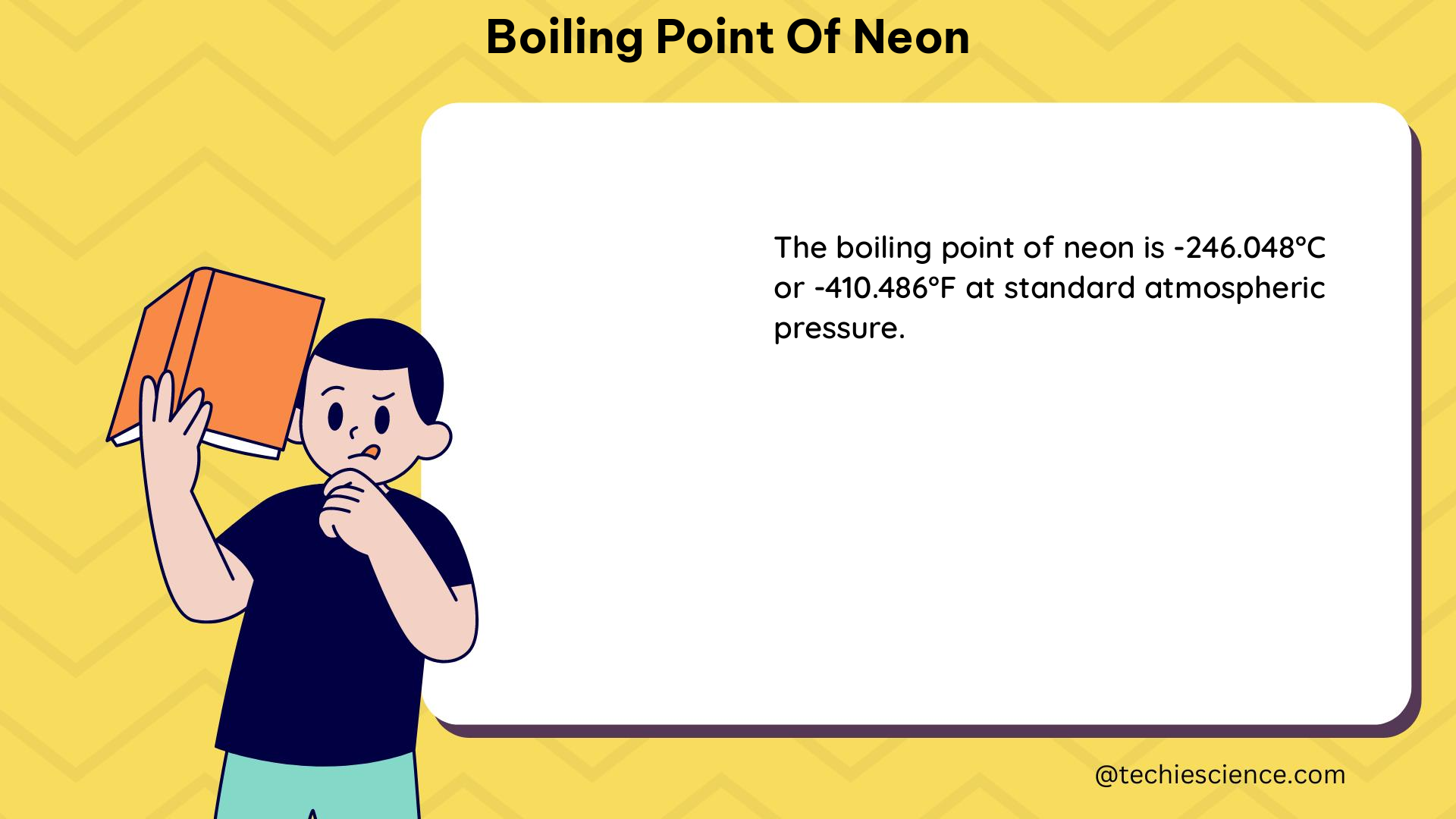The boiling point of neon, a rare and inert gas, is precisely -246.048°C (-411°F) under standard atmospheric conditions. This fixed physical property of neon is determined by the strength of the interatomic forces present in its molecular structure, which govern the temperature at which the vapor pressure of the substance equals the surrounding atmospheric pressure, causing it to transition from a liquid to a gaseous state.
Understanding the Boiling Point of Neon
The boiling point of a substance is the temperature at which the vapor pressure of the liquid equals the pressure surrounding the liquid, and bubbles of vapor form inside the liquid. This transition from liquid to gas occurs because the intermolecular forces holding the liquid together are no longer strong enough to keep the molecules in the liquid state.
For neon, the boiling point is influenced by several factors, including:
-
Intermolecular Forces: Neon, being a noble gas, has very weak intermolecular forces, known as van der Waals forces, which are responsible for the low boiling point. These forces are much weaker than the covalent or ionic bonds found in other substances.
-
Atomic Structure: Neon has an atomic number of 10 and an atomic weight of 20.183 g/mol. Its electron configuration of 1s^2 2s^2 2p^6 results in a stable, closed-shell structure, contributing to the low boiling point.
-
Pressure: The boiling point of neon, like any substance, is influenced by the surrounding pressure. At standard atmospheric pressure (1 atm), neon boils at -246.048°C. However, the boiling point can be altered by changing the pressure, as described by the Clausius-Clapeyron equation:
ln(P2/P1) = (ΔHvap/R)*(1/T1 - 1/T2)
where P1 and P2 are the vapor pressures at temperatures T1 and T2, respectively, ΔHvap is the enthalpy of vaporization, and R is the universal gas constant.
- Density: The density of neon at 1 atm and 0°C is 0.89990 g/L, which is significantly lower than the density of other gases, such as oxygen (1.429 g/L) and nitrogen (1.251 g/L). This low density is a result of the weak intermolecular forces and contributes to the low boiling point.
Practical Applications of Neon’s Boiling Point

The precise boiling point of neon has numerous practical applications in various scientific and industrial fields:
-
Cryogenics: Neon’s extremely low boiling point makes it a valuable cryogenic fluid, used in applications such as superconducting magnets, particle accelerators, and infrared detectors, where temperatures below -200°C are required.
-
Lighting and Displays: Neon’s characteristic red-orange glow when excited by an electric current is utilized in neon lamps and signs, as well as in plasma displays for televisions and computer monitors.
-
Leak Detection: Due to its inert nature and low boiling point, neon is often used as a tracer gas in leak detection systems, where its presence can be easily detected even in small quantities.
-
Laser Technology: Neon is used in the construction of certain types of lasers, such as the helium-neon (HeNe) laser, which is commonly used in barcode scanners, alignment tools, and other low-power applications.
-
Thermometry: The boiling point of neon is used as a reference point in the definition of the Kelvin temperature scale, which is the base unit of temperature in the International System of Units (SI).
Neon’s Unique Properties and Characteristics
In addition to its boiling point, neon exhibits several other unique physical and chemical properties:
-
Melting Point: The melting point of neon is -248.67°C (-415.5°F), making it one of the most difficult substances to solidify.
-
Oxidation State: Neon has an oxidation state of 0, as it is a noble gas and does not form any stable chemical compounds under normal conditions.
-
Electron Configuration: Neon has the electron configuration of 1s^2 2s^2 2p^6, which gives it a stable, closed-shell structure and contributes to its inert nature.
-
Thermal Conductivity: Neon has a relatively low thermal conductivity of 0.0491 W/(m·K) at 0°C, which is lower than that of other common gases, such as air (0.0262 W/(m·K)).
-
Specific Heat Capacity: The specific heat capacity of neon is 1.03 J/(g·K) at constant pressure, which is lower than that of other gases like nitrogen (1.04 J/(g·K)) and oxygen (0.92 J/(g·K)).
These unique properties of neon, combined with its extremely low boiling point, make it a valuable and versatile element in various scientific and industrial applications.
Conclusion
The boiling point of neon, precisely -246.048°C (-411°F), is a fundamental physical property that is determined by the strength of the interatomic forces within its molecular structure. This low boiling point, along with neon’s other unique characteristics, such as its inert nature, low thermal conductivity, and specific heat capacity, make it a valuable element in a wide range of applications, from cryogenics and lighting to laser technology and thermometry. Understanding the factors that influence neon’s boiling point and its practical applications is crucial for scientists, engineers, and researchers working in various fields.
References:
- Lide, D. R. (2005). CRC Handbook of Chemistry and Physics, 86th Edition. CRC Press.
- Atkins, P., & de Paula, J. (2014). Atkins’ Physical Chemistry (10th ed.). Oxford University Press.
- Haynes, W. M. (2016). CRC Handbook of Chemistry and Physics, 97th Edition. CRC Press.
- Sears, F. W., & Salinger, G. L. (1975). Thermodynamics, Kinetic Theory, and Statistical Thermodynamics (3rd ed.). Addison-Wesley.
- Levine, I. N. (2009). Physical Chemistry (6th ed.). McGraw-Hill.

The lambdageeks.com Core SME Team is a group of experienced subject matter experts from diverse scientific and technical fields including Physics, Chemistry, Technology,Electronics & Electrical Engineering, Automotive, Mechanical Engineering. Our team collaborates to create high-quality, well-researched articles on a wide range of science and technology topics for the lambdageeks.com website.
All Our Senior SME are having more than 7 Years of experience in the respective fields . They are either Working Industry Professionals or assocaited With different Universities. Refer Our Authors Page to get to know About our Core SMEs.